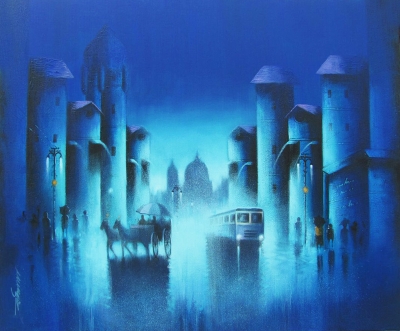Can we help you with Finding your favorite piece of art? Reach out to us by clicking below.
The Power & Unique Qualities of Oil in Abstract Art
Abstract oil paintings hold a unique place in the world of art, blending the rich history of oil as a medium with the expressive freedom of abstract forms. Unlike traditional representational art, abstract oil paintings focus on color, texture, and form rather than depicting recognizable subjects. This approach allows artists to convey emotions, ideas, and impressions in a way that transcends the literal, inviting viewers to engage with the artwork on a deeper, more personal level.
Oil paint is celebrated for its versatility and depth, making it an ideal medium for abstract art. The slow drying time of oil paints allows artists to manipulate the paint on the canvas for extended periods, blending colors and layering textures to create complex, multi-dimensional effects. This ability to build up layers of paint enables the creation of depth and movement, which are often key elements in abstract compositions.
Oil paints are also known for their rich, vibrant colors and their capacity to hold pigment well, resulting in intense hues that can evoke powerful emotions. The medium's ability to produce both subtle gradations and bold, dramatic contrasts allows abstract artists to explore a wide range of visual expressions, from calm and serene to dynamic and chaotic.
The texture that can be achieved with oil paint is another aspect that makes it particularly suited to abstract art. Artists can create a tactile surface that adds another layer of meaning to the work, with thick impasto techniques or delicate glazes. This textural variety not only enhances the visual impact of the painting but also engages the viewer's sense of touch, even if only imaginatively.
Notable Artists Who Used Oil in Abstract Art
Wassily Kandinsky: Often regarded as the father of abstract art, Kandinsky used oil paints to explore the emotional and spiritual potential of color and form. His works, such as "Composition VII," demonstrate the fluidity and intensity that oil paints can achieve.
Mark Rothko: Rothko's large-scale abstract paintings, characterized by their fields of color and soft edges, are powerful examples of how oil paint can be used to create mood and evoke deep emotional responses. His use of oil allowed for the blending and layering that give his works their characteristic luminosity.
Jackson Pollock: Known for his "drip" technique, Pollock's abstract expressionist works, such as "No. 5, 1948," showcase the dynamic potential of oil paint. His method of pouring and splattering paint onto the canvas created a sense of movement and energy that was groundbreaking in abstract art.
Gerhard Richter: A contemporary master of abstraction, Richter uses oil paint to create complex, layered compositions that blur the line between abstraction and realism. His "Abstract Paintings" series is a testament to the versatility of oil as a medium, with its ability to create both sharp contrasts and smooth transitions.


 Price
Price
 Size
Size

 Orientation
Orientation
 Color
Color
 Style
Style
 Categories
Categories
 Sort
Sort




.jpg)
.jpg)




.jpg)




 '
'
.jpg) '
'
 '
'
 '
'


